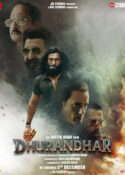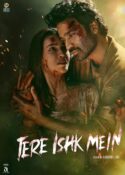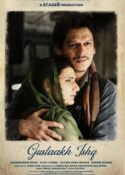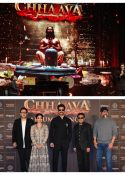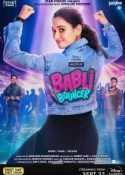 Subhash K Jha returns his focus to the brilliant Gully Boy, Zoya Akhtar’s ode to the underground hip-hop scene starring Ranveer Singh and Alia Bhatt. Zoya also delves deep and shares insight into the film, including casting, filming, and what she feels is the essence of the film.
Subhash K Jha returns his focus to the brilliant Gully Boy, Zoya Akhtar’s ode to the underground hip-hop scene starring Ranveer Singh and Alia Bhatt. Zoya also delves deep and shares insight into the film, including casting, filming, and what she feels is the essence of the film.
In the magical hands of Zoya Akhtar the familiar tale acquires a texture and tone all of its own. Tone bole toh…the music and the songs of this subtle and rich film abide absolutely and unconditionally with the hip-hop aspirations of its hero Ranveer Singh as Murad.
Gully Boy moves in expected yet mysterious ways. Tracking down Murad’s dreams to fruition, Zoya Akhtar doesn’t miss a single heartbeat. She gathers the sounds, sights, and smells into a warm embrace that expresses a cross between warm acceptance and uncomplaining despair. Embodying this undefeated spirit of Mumbai is Murad, Zoya Akhtar’s hero in a film that has many heroes.
It is a common cliché to exclaim after every film that is set in Mumbai that it captures the city like never before. But Gully Boy actually does it like never before. The crowded chawls where, as a touristic film crew that comes visiting the slum, marvels, every inch of space available in the rooms is used by its inhabitants.
Zoya does the same. She doesn’t allow even a moment of her generous playing time to be frittered in frivolity—not that the film is devoid of fun and laughter.
Tightly squeezing into the kerchief-sized rooms of the slum, Murad simply wants to fly. His face lights up each time he meets the love of his life, Saifina. Alia Bhatt, with her head veiled and smile unveiled, plays Saifina with an impish charm that brings sunshine into not just Murad’s heart but also ours. We, too, wonder what life would be like without her kindred presence.
That brings me to Ranveer Singh’s rapper role with a dream that won’t be cut down to size. The actor disappears into his character in every conceivable sense. When he speaks, he’s a hesitant chawl ka chokra trying to grope his way through the dark alleys of his unfathomable dreams. When he is with his ill-treated mother (Amruta Subhash, with a face that launches a thousand slips), he is that devoted son who just wants to kill his brutally self-serving father (Vijay Raaz, an actor who can never get it wrong).
Ah, but when he is with Saifeena, Murad is like a deserter drinking water. Propitiously, Murad and Saifeena don’t sing a romantic duet. The focus is on the hip-hop and rap. The duets can go take a hike. Shankar Mahadevan’s feral sounds jump out of the screen to grab us whenever Murad and mentor-friend Sher (Siddharth Chaturdevi, a natural-born scene-stealer) jam together.
Yes, this is Mumbai like never before. The city is shot exquisitely by Jay Oza with minimal embellishment and maximum picture-postcard purity. If the camera never lies, Zoya’s universe of bridled despair is buying that.
In the second half, some of the scenes seem underwritten. How did Murad allow the fey Sky (Kalki Koechlin, charming) to get so close to him when he has known from age 13 that he can marry only one girl. And that is Saifeena. Alia and Ranveer’s relationship contextualizes the drama to a point of enlightened lucidity. We can’t miss the sheer force of the love that these two fighting spirits feel for one another.
This is why I found their temporary separation in the second-half to strenuously designed for drama. Arrey yaar, we all know Murad can’t look at anyone else. Saifeena makes sure of that. Kalki makes the mistake of doing much more than looking. She ends up with a broken bottle on her head. If Saifeena wasn’t in love, she’d be psychotic.
The certainty that Zoya Akhtar imbues in almost every frame comes from a self-awareness that eschews overstatement. Zoya is the only big-time mainstream filmmaker I know who doesn’t take the audience’s intelligence for granted. The scenes are never overexplained and, hence, never overwritten.
Zoya and Reema Kagti’s writing surrenders to Mumbai’s city’s class differences with a sigh that never grows into a groan. The drama is distilled in faith and an understanding of the power structure that makes the city so throbbing and vibrant. While Ranveer Singh’s performance anchors the narrative’s implosive energy, the sound design and the songs are used to indicate the hero’s losing battle with conformity.
Gully Boy pulsates with the music of anxious yearnings. Sometimes, we strain to hear the sound of distant anxiety. There is a sequence where Ranveer’s Murad plays chauffeur to an upper-class girl sobbing in the backseat. Murad remains sullen and silent on the wheel. But his voice comes alive in the background to create a song on class distinction on the front seat of the car.
By the time this masterly study of self-discovery comes to a screeching halt, the film’s vilest character, Murad’s father, has found his lost humanism. No, it isn’t too late for him to make up for lost time. Gully Boy tells us it is never too late to find one’s bearings in life. The time to follow our dreams is now. Because as Zoya Akhtar has already warned us earlier, zindagi na milegi dobara.
When asked what inspired her to make a film about hip-hop music, the director said that she was a fan of hip-hop music herself and has listened to tracks by American hip-hop musicians. “I was always interested in hip-hop music. I’d listen more to the American hip-hop musicians. Then I discovered the throbbing desi hip-hop culture. I had to interact with the Mumbai hip-hop musicians. Gully Boy reflects their struggle. I started exploring their world, their lives, their trials and tribulations. I needed to marinate in their world. I met them and their families. It was a huge unexplored world that opened up to media, and I was completely hooked.
Adding, “The entire hip-hop culture was opened up to us. We just needed to dip into it and come up with whatever we wanted to say on screen. It is an experience I won’t forget easily. I was very lucky to have producers like Ritesh Sidhwani and Farhan Akhtar. They let me make whatever I want to. I wonder what other producers in their place would have said if I had gone to say, ‘I want to make a film about a hip-hop singer from Dharavi.”
Gully Boy normalized the Muslim community. Zoya says. “No community or culture is normalized in mainstream Hindi cinema. I don’t think the characters are always written well. They caricature women, homosexuals, and disabled people. It’s across the board. It’s not about a particular community or gender. They even caricature men in our movies. You know, that whole toxic masculinity thing. So what is ‘normal’ in our films? Most scripts operate on the level of conjecture. We see an IDEA of how a woman should be or how a homosexual should behave. Nobody is like that (the way shown in many films). I don’t know why they don’t treat the visual medium as a visual medium. The audience is spoon-fed every morsel of information through the dialogues. Arrey, the audience can see! I don’t know why cinema is largely regarded as an aural medium in mainstream cinema. Every decade has had mainstream filmmakers who give us believable, tenable characters. In the 1950s, which I feel was the best era of Hindi cinema, where entertainment combined with social consciousness, we had Bimal Roy, Raj Kapoor, and Guru Dutta. Then, in the 1960s, the Hrishikesh Mukherjee started.”
Asked about the director who influenced Zoya, she replied. “Among the Indian ones, I’d say Mira Nair, Shephard Kapoor, Mahesh Bhatt, and of course Guru Dutta, Satyajit Ray … I’ve seen all their work.”
Zoya also revealed that Alia Bhatt’s character in Gully Boy was written for another film. “Actually, my co-writer Reema Kagti had written this character for another film. Of course, we adapted the character to our own requirements in Gully Boy. Alia is brilliant in the film. As for Siddhant Chaturvedi, it just happened. He was the last to be cast. We were just three weeks away from shooting. And I wasn’t happy with anyone I had seen. Suddenly, one evening, I spotted him at a party. He was dancing like there was no tomorrow. And man, he could really move. I introduced myself. He said he knew who I was, and he was dancing to show me what he could do. I called him for an audition the next day, and that was it. Siddhanth was manna from heaven. If I hadn’t found him, I would have had to compromise on my casting.”
“I really want to make my films on any and every kind of theme that fascinates me. Tomorrow I may decide to make a film about a Mexican family. I wouldn’t be bothered with which strata of society they belong to. I want to able to seek the humanity of my characters. I want to transcend the barriers of class and creed. The filmmakers that I admire are those who address themselves to the human spirit. As a storyteller, I want to be able to make every kind of film. And by the way, the protagonist in my short film Bombay Talkies was a house help,” she added.
Zoya Akhtar feels Gully Boy reached out so far because of the class issue. “A boy from the underprivileged class chasing his dream is a theme everybody identifies with. Somewhere, it resonated with the entire population. I think the line from Gully Boy, ‘Kisske liye aasan hai? (Who has it easy?)’ is true for everyone. No one gets success easily. Everyone has his own struggle. But it comes from the same place.”




